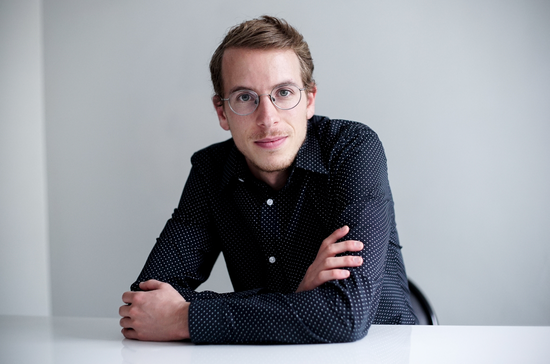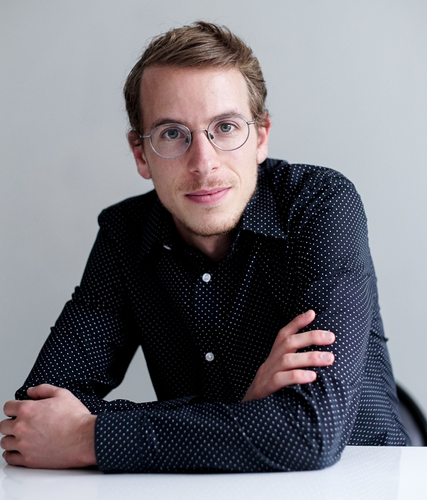Oren Boneh en studio
De Lubitsch à Lynch | Enjeux artistiques
Quand on lui demande ce qui l’intéresse tant dans la composition d’une musique pour un film muet, la première chose que mentionne Oren Boneh, c’est son amour pour les situations absurdes du quotidien : « Nous faisons tant d’efforts pour tenter de garder le contrôle sur nos vies, pour en éliminer les arbitraires de l’univers : l’absurdité est ce qui survient lorsque l’arbitraire déchire la surface de cette maîtrise illusoire. Dans les films muets comiques, et particulièrement dans Quand j’étais mort de Lubitsch, ces absurdités du quotidien sont souvent au premier plan de l’intrigue.  La musique peut mettre l’accent dessus, ou jouer avec la relation image/son pour perturber la perception des images, jusqu’à altérer l’expérience émotionnelle du film. Concernant Quand j’étais mort, l’imagerie de Lubitsch laisse un espace à la musique et à son pouvoir recontextualisant – le sourire soudain carnassier du mari, par exemple, peut être nuancé par la partition d’une sous-couche de souffrance. »
La musique peut mettre l’accent dessus, ou jouer avec la relation image/son pour perturber la perception des images, jusqu’à altérer l’expérience émotionnelle du film. Concernant Quand j’étais mort, l’imagerie de Lubitsch laisse un espace à la musique et à son pouvoir recontextualisant – le sourire soudain carnassier du mari, par exemple, peut être nuancé par la partition d’une sous-couche de souffrance. »
Le cinéma muet de Lubitsch présente un défi supplémentaire pour le compositeur : la fameuse « Lubitsch touch », tant vantée par les cinéphiles. « Ce qui me fascine dans le style de Lubitsch est son attention aux détails – des détails minuscules mais essentiels, suggérant un sens caché sous la surface d’une société qui en semble dépourvue. Lubitsch fait des choix narratifs audacieux pour mêler subtilement une forme de fraîcheur à un sentiment d’inéluctable. Ces petits gestes individuels, expressions faciales et autres gags ont été ma porte d’entrée dans le film, façonnant mon vocabulaire musical. Cela dit, au-delà de ce niveau granulaire, deux autres dimensions se dégagent. À un niveau intermédiaire, on découvre ainsi les trois principaux protagonistes – le mari rusé, l’épouse soupçonneuse, et la sorcière de belle-mère – et les conflits spécifiques qui animent l’intrigue. Enfin, en dézoomant complètement, on embrasse l’architecture générale du film, défait de ses détails idiomatiques (selon l’écrivain Kurt Vinnegut, c’est l’intrigue archétypale de « l’homme dans un trou » ). C’est à ce niveau que j’ai bâti la forme musicale et organisé les variations d’énergie. »
« Mon objectif principal est de focaliser l’attention de l’auditeur.rice sur le film, et non de l’en distraire. Cela suppose de chercher l’essence de chaque personnage, à la fois sa nature caricaturale et les multiples couches de sa personnalité. Une approche possible implique un bruitage littéral exagéré, taillé sur mesure pour exprimer des événements physiques spécifiques. Je m’inspire notamment des courts métrages d’animation en stop-motion de Jan Švankmajer, dans lesquels des sons acoustiques comiques se joignent à des images surréelles pour générer un sens viscéral pour les spectateur.rice.s.
Une deuxième approche trouve sa source dans les films de David Lynch, qui crée le mystère en surimposant les textures musicales sombres d’Angelo Badalamenti à des images émotionnellement neutres, jouant ainsi avec les clichés du film noir. Cette approche a d’ailleurs été poussée au comble du ridicule par les vidéos virales de Sein Peaks, qui surimposent la musique iconique de Badalamendi pour Twin Peaks sur des scènes de la sitcom des années 1990 Seinfeld : cette combinaison assumée transforme la comédie du quotidien en un suspense ostensiblement horrifique, jusqu’à l’absurde. Là encore, le comique exagéré de Lubitsch se prête à une telle approche. La musique de film peut ainsi, parfois de manière subliminale, nuancer les émotions des spectateur.rice.s sans qu’il s’en aperçoivent. Ces deux approches, par contraste, élèvent la musique au même plan de conscience que l’image, sans craindre de jouer avec les attentes des spectateur.rice.s et même avec les clichés. »
Le comique de l’électronique | Enjeux technologiques
 Scott Eyman, biographe de Lubitsch, écrivait que ses films « ne se passent ni en Europe, ni en Amérique, mais en Lubitschland ». Pour Oren Boneh, l’électronique nous aide à nous y rendre. Dialoguant étroitement avec l’ensemble instrumental au sein d’un univers sonore immersif, les outils d’informatique musicale sont mis au service du contrepoint qu’offre le son à l’image. « Ce qui est particulièrement passionnant, c’est d’utiliser – avec l’aide perspicace du réalisateur en informatique musicale Dionysios Papanikolaou – des moyens électroniques complètement anachroniques par rapport au film, qui a été réalisé il y a plus de 100 ans », dit Oren Boneh.
Scott Eyman, biographe de Lubitsch, écrivait que ses films « ne se passent ni en Europe, ni en Amérique, mais en Lubitschland ». Pour Oren Boneh, l’électronique nous aide à nous y rendre. Dialoguant étroitement avec l’ensemble instrumental au sein d’un univers sonore immersif, les outils d’informatique musicale sont mis au service du contrepoint qu’offre le son à l’image. « Ce qui est particulièrement passionnant, c’est d’utiliser – avec l’aide perspicace du réalisateur en informatique musicale Dionysios Papanikolaou – des moyens électroniques complètement anachroniques par rapport au film, qui a été réalisé il y a plus de 100 ans », dit Oren Boneh.
« Suite à l’enregistrement de plus de sept heures d’improvisation sur le rack de synthèse modulaire de l’Ircam, j’ai été bouleversé par l’expressivité de cet instrument. Cette découverte, et le catalogue de sons que j’ai constitué par la suite, ont profondément influencé mon écriture instrumentale. À l’inverse, certains passages instrumentaux m’ont amené à utiliser l’électronique comme miroir sonore de l’ensemble. »
D’un point de vue plus pratique, le rôle principal dévolu à l’électronique est de souligner l’humour du film, au moyen notamment de sons anachroniques ou de bruitages exagérés : « Par exemple, dit le compositeur, les sons de synthèse dont j’accompagne les gestes des personnages ne correspondent souvent pas tout à fait audit mouvement. Avec le synthétiseur RAVE, qui s’appuie sur des modèles d’apprentissage profond, nous avons aussi produit toute une série de sons grotesques qui contrastent comiquement avec les scènes douces et raffinées qu’ils accompagnent. L’informatique musicale nous sert également à étendre les textures de l’ensemble instrumental : dans les passages extrêmement rythmés, l’électronique accentue certains aspects des textures instrumentales pour les rendre plus vraies que nature, en brouillant la nature des sons, informatique ou acoustique. »
![]()
Photo 1 : Le compositeur Oren Boneh © Juan Francisco Gonzalez
Photo 2 : Le compositeur Oren Boneh et le réalisateur en informatique musicale Dionysios Papanikolaou en studio à l'Ircam




